brake CITROEN C4 2019 Owners Manual
[x] Cancel search | Manufacturer: CITROEN, Model Year: 2019, Model line: C4, Model: CITROEN C4 2019Pages: 317, PDF Size: 9.31 MB
Page 5 of 317
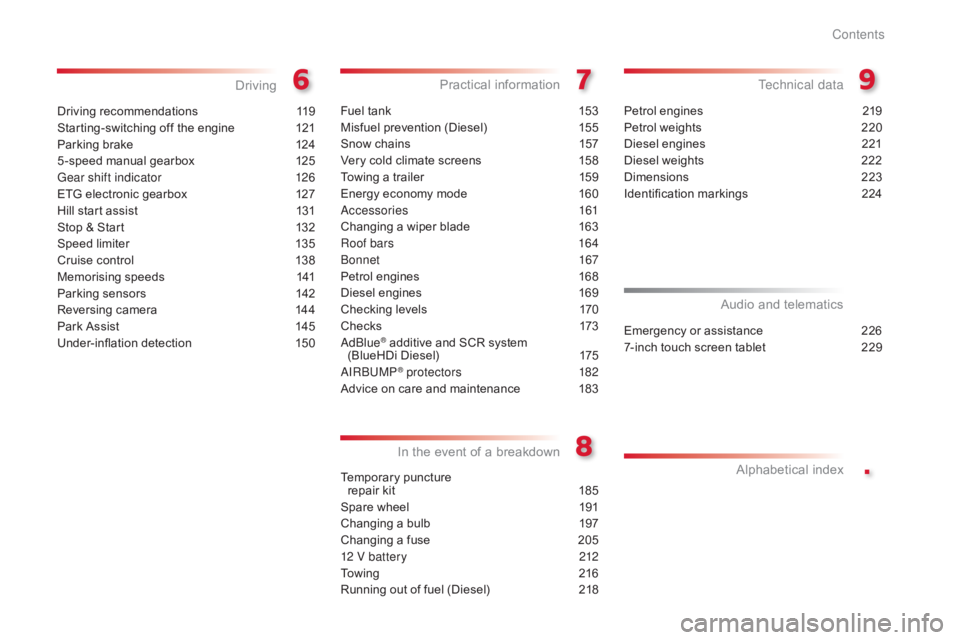
.
C4-cactus_en_Chap00a_sommaire_ed01-2016
Drivingô recommendationsô 119
Starting-switching ô off ô the ô engine ô
1
21
Parking
ô brake ô
1
24
5 -speed
ô manual ô gearbox ô
1
25
Gear shift indicator
1
26
ETG
ô electronic ô gearbox ô
1
27
Hill
ô start ô assist ô
1
31
Stop
ô & ô Start ô
1
32
Speed
ô limiter ô
1
35
Cruise
ô control ô
1
38
Memorising
ô speeds ô
1
41
Parking
ô sensors ô
1
42
Reversing
ô camera ô
1
44
Park
ô Assist ô
1
45
Under-inflation
ô d
etection
ô 1
50
Driving
Fuelô tankô 1 53
Misfuel ô prevention ô (Diesel) ô
1
55
Snow
ô chains ô
1
57
Very
ô cold ô climate ô screens ô
1
58
Towing
ô a ô trailer ô
1
59
Energy
ô economy ô mode ô
1
60
Accessories
161
Changing
ô a ô wiper ô blade ô
1
63
Roof bars
1
64
Bonnet
167
Petrol
ô engines ô
1
68
Diesel
ô engines ô
1
69
Checking
ô levels ô
1
70
Checks
ô 1
73
AdBlue
ôÛô additiveô andô SCRô systemô
(
BlueHDi ô Diesel) ô 1 75
AIRBUMP
ôÛ protectors 1 82
Advice
ô
on
ô
care ô and ô maintenance ô
1
83
Practicalô information
Temporaryô punctureô
r epair ô kit ô 1 85
Spare
ô wheel ô
1
91
Changing
ô a ô bulb ô
1
97
Changing
ô a ô fuse ô
2
05
12 V battery
2
12
To w i n g
ô 2
16
Running
ô out ô of ô fuel ô (Diesel) ô
2
18
Inô theô event ô o f ô a ô b reakdown
Petrolô enginesô 2 19
Petrol ô weights ô
2
20
Diesel
ô engines ô
2
21
Diesel
ô weights ô
2
22
Dimensions
ô 2
23
Identification
ô ma
rkings
ô 2
24
Technical data
Emergencyô orô assistanceô 226
7-inch ô touch ô screen ô tablet ô
2
29
Audioô andô telematics
Alphabetical
ô in
dex
Contents
Page 6 of 317
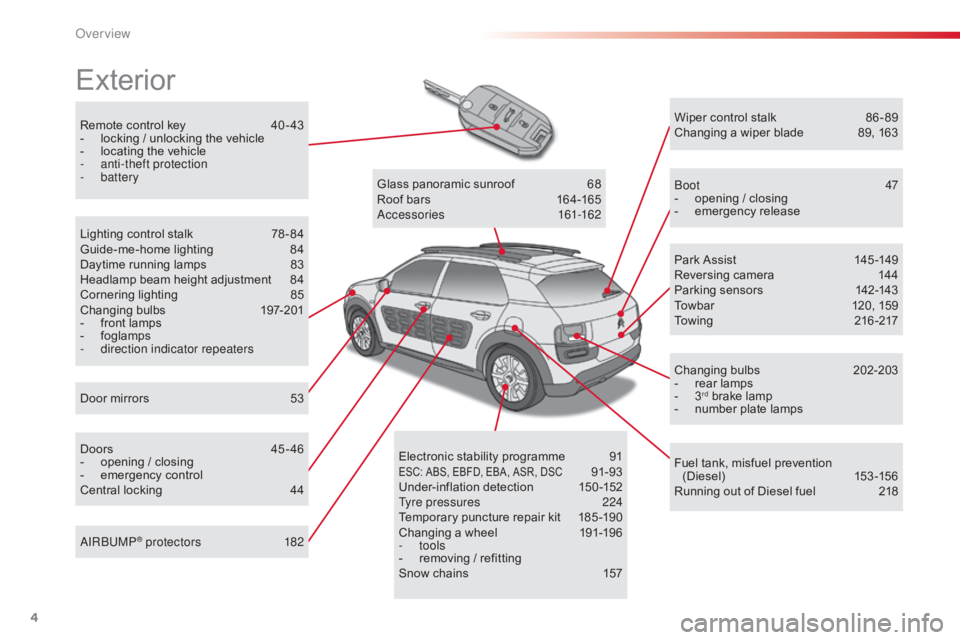
4
C4-cactus_en_Chap00b_vue-ensemble_ed01-2016
Remoteô controlô keyô 40 - 43
- ô l ocking ô / ô unlocking ô the ô vehicle
-
ô
l
ocating ô the ô vehicle
-
a
nti-theft protection
-
battery
Exterior
Doorô mirrorsô 5 3
Lighting ô control ô stalk ô
7
8 - 84
Guide-me-home ô lighting ô
8
4
Daytime ô running ô lamps ô
8
3
Headlamp ô beam ô height ô adjustment ô
8
4
Cornering ô lighting ô
8
5
Changing
ô bu
lbs
ô 1
97-201
- ô
f
ront ô lamps
-
ô fo
glamps
-
d
irection indicator repeaters
Doors ô
4
5 - 46
-
ô
o
pening ô / ô closing
-
ô em
ergency
ô c
ontrol
Central
ô locking ô
4
4Glass
ô panoramic ô sunroof ô
6
8
Roof ô bars ô
1
64-165
Accessories
1
61-162
Wiper ô control ô stalk ô
8
6 - 89
Changing ô a ô wiper ô blade ô
8
9, ô 163
Boot
47
- ô
o
pening ô / ô closing
-
ô em
ergency
ô r
elease
Park ô Assist ô
1
45 -149
Reversing ô camera ô
1
44
Parking ô sensors ô
1
42-143
Towbar ô
1
20, ô 159
Towing
ô 21
6 -217
Changing
ô bu
lbs
ô 2
02-203
- ô r ear ô lamps
- ô 3rdô brakeô lamp
-
ô n
umber ô plate ô lamps
Fuel
ô
tank, ô misfuel ô prevention ô
(
Diesel)
ô 15
3 -15 6
Running
ô out ô of ô Diesel ô fuel ô
2
18
Electronic
ô s
tability
ô pro
gramme
ô 9
1
ESC:ô ABS,ô EBFD,ô EBA,ô ASR,ô DSCô 91-93
Under-inflationô d
etectionô 1 50-152
Tyre pressures
2
24
Temporary
ô
puncture
ô
repair
ô
kit
ô
1
85 -190
Changing
ô
a
ô
wheel
ô
1
91-196
-
tools
-
ô
r
emoving
ô
/
ô
refitting
Snow
ô
chains
ô
1
57
AIRBUMP
ôÛ protectors 1
82
Over view
Page 8 of 317
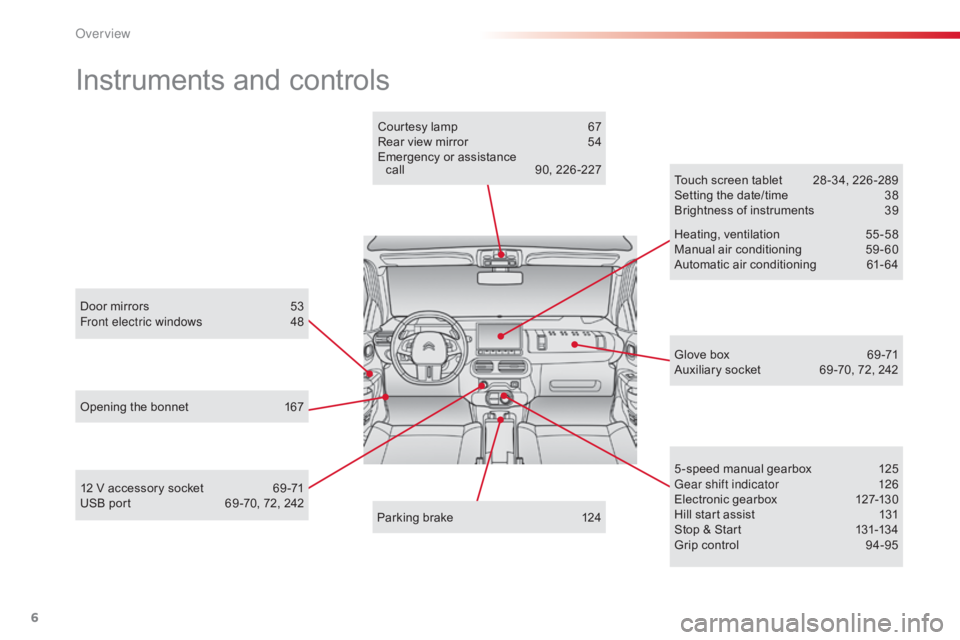
6
C4-cactus_en_Chap00b_vue-ensemble_ed01-2016
Instrumentsô andô controls
Doorô mirrorsô 53
Front electric windows 4 8
Opening
ô the ô bonnet ô
1
67 Touch
ô screen ô tablet ô
2
8 -34, ô 226 -289
Setting ô the ô date/time ô
3
8
Brightness ô of ô instruments ô
3
9
Heating,
ô v
entilation
ô 5
5-58
Manual
ô a
ir
ô c
onditioning
ô 5
9-60
Automatic ô air ô conditioning ô
6
1- 64
5 -speed ô manual ô gearbox ô
1
25
Gear shift indicator
1
26
Electronic
ô gearbox ô
1
27-130
Hill
ô start ô assist ô
1
31
Stop
ô & ô Start ô
1
31-134
Grip
ô control ô
9
4-95
Glove
ô box ô
6
9 -71
Auxiliary
ô socket ô
6
9 -70, ô 72, ô 242
Courtesy
ô lamp ô
6
7
Rear ô view ô mirror ô
5
4
Emergency ô or ô assistance ô
c
all ô
9
0, ô 226 -227
Parking ô brake ô
1
24
12
ô V ô accessory ô socket ô
6
9 -71
USB
ô port ô ô
6
9 -70, ô 72, ô 242
Over view
Page 11 of 317
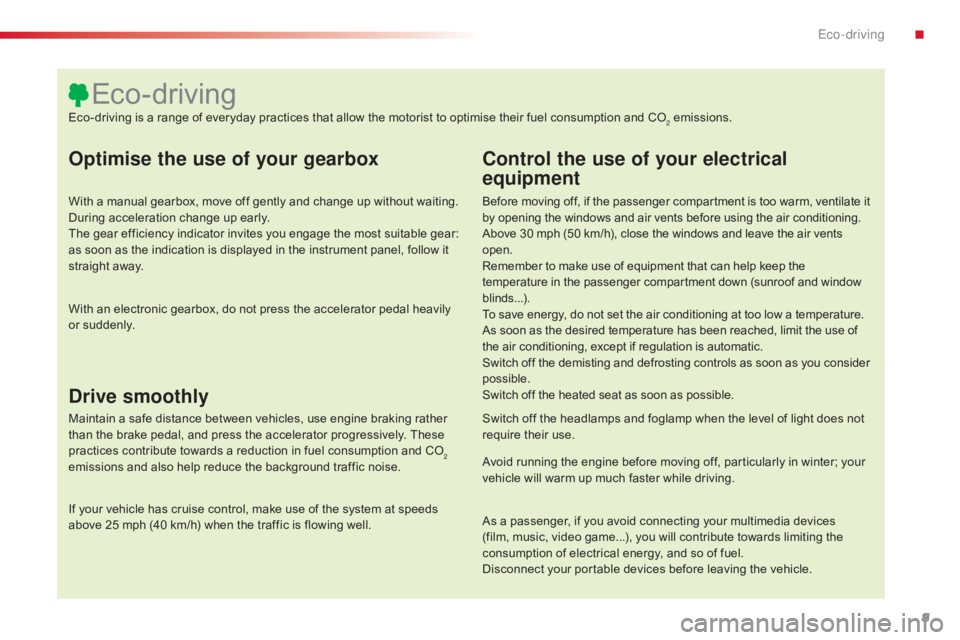
9
C4-cactus_en_Chap00c_eco-conduite_ed01-2016
Optimise the use of your gearbox
Withô aô manualô gearbox,ô moveô offô gentlyô andô changeô upô withoutô waiting.ô During ô acceleration ô change ô up ô early.
The
ô gear ô efficiency ô indicator ô invites ô you ô engage ô the ô most ô suitable ô gear: ô
a
s ô soon ô as ô the ô indication ô is ô displayed ô in ô the ô instrument ô panel, ô follow ô it ô
s
traight ô away.
Control the use of your electrical
equipment
Beforeô movingô off,ô ifô theô passengerô compartmentô isô tooô warm,ô ventilateô itô by ô opening ô the ô windows ô and ô air ô vents ô before ô using ô the ô air ô conditioning.
Above
ô 30 ô mph ô (50 ô km/h), ô close ô the ô windows ô and ô leave ô the ô air ô vents
ô ope
n.
Remember
ô to ô make ô use ô of ô equipment ô that ô can ô help ô keep ô the
ô t
emperature ô in ô the ô passenger ô compartment ô down ô (sunroof ô and ô window
ô b
linds...).
To
ô save ô energy, ô do ô not ô set ô the ô air ô conditioning ô at ô too ô low ô a ô temperature.
As
ô soon ô as ô the ô desired ô temperature ô has ô been ô reached, ô limit ô the ô use ô of
ô t
he ô air ô conditioning, ô except ô if ô regulation ô is ô automatic.
Switch
ô off ô the ô demisting ô and ô defrosting ô controls ô as ô soon ô as ô you ô consider
ô p
ossible.
Switch
ô off ô the ô heated ô seat ô as ô soon ô as ô possible.
Switch
ô off ô the ô headlamps ô and ô foglamp ô when ô the ô level ô of ô light ô does ô not ô
r
equire ô their ô use.
Avoid
ô running ô the ô engine ô before ô moving ô off, ô particularly ô in ô winter; ô your ô
v
ehicle ô will ô warm ô up ô much ô faster ô while ô driving.
As
ô a ô passenger, ô if ô you ô avoid ô connecting ô your ô multimedia ô devices ô
(
film, ô music, ô video ô game...), ô you ô will ô contribute ô towards ô limiting ô the ô
c
onsumption ô of ô electrical ô energy, ô and ô so ô of ô fuel.
Disconnect
ô your ô portable ô devices ô before ô leaving ô the ô vehicle.
Eco-driving
Eco-drivingô isô aô rangeô ofô everydayô practicesô thatô allowô theô motoristô toô optimiseô theirô fuelô consumptionô andô CO2ô emissions.
With
ô
an
ô
electronic
ô
gearbox,
ô
do
ô
not
ô
press
ô
the
ô
accelerator
ô
pedal
ô
heavily
ô
o
r
ô s
uddenly.
Drive smoothly
Maintainô aô safeô distanceô betweenô vehicles,ô useô engineô brakingô ratherô t han ô the ô brake ô pedal, ô and ô press ô the ô accelerator ô progressively. ô These ô
p
ractices ô contribute ô towards ô a ô reduction ô in ô fuel ô consumption ô and ô CO
2
emissions
ô
and
ô
also
ô
help
ô
reduce
ô
the
ô
background
ô
traffic
ô
noise.
If
ô
your
ô
vehicle
ô
has
ô
cruise
ô
control,
ô
make
ô
use
ô
of
ô
the
ô
system
ô
at
ô
speeds
ô
a
bove
ô
25
ô
mph
ô
(40
ô
km/h)
ô
when
ô
the
ô
traffic
ô
is
ô
flowing
ô
well.
.
Eco-driving
Page 16 of 317
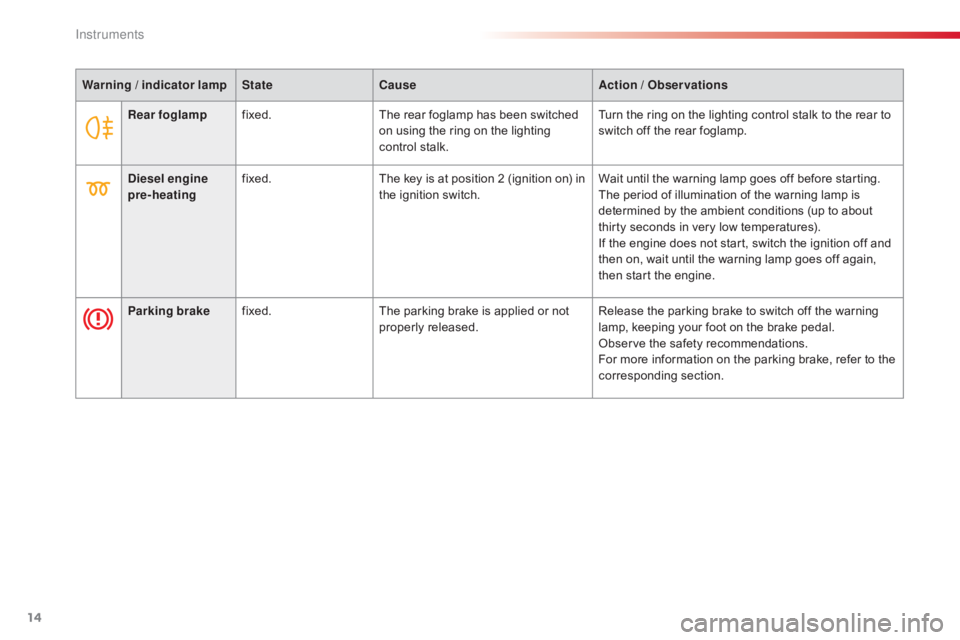
14
C4-cactus_en_Chap01_Instruments-de-bord_ed01-2016
Rear foglampfixed. The ô rear ô foglamp ô has ô been ô switched ô o
n ô using ô the ô ring ô on ô the ô lighting ô
c
ontrol ô stalk.Turn
ô the ô ring ô on ô the ô lighting ô control ô stalk ô to ô the ô rear ô to ô s
witch ô off ô the ô rear ô foglamp.
Diesel engine
pre-heating fixed.
The
ô key ô is ô at ô position ô 2 ô (ignition ô on) ô in ô
t
he ô ignition ô switch.Wait
ô until ô the ô warning ô lamp ô goes ô off ô before ô starting.
The
ô period ô of ô illumination ô of ô the ô warning ô lamp ô is ô
d
etermined ô by ô the ô ambient ô conditions ô (up ô to ô about ô
t
hirty ô seconds ô in ô very ô low ô temperatures).
If
ô the ô engine ô does ô not ô start, ô switch ô the ô ignition ô off ô and ô
t
hen ô on, ô wait ô until ô the ô warning ô lamp ô goes ô off ô again, ô
t
hen ô start ô the ô engine.
Parking brake fixed. The
ô parking ô brake ô is ô applied ô or ô not ô
p
roperly
ô r
eleased.Release
ô the ô parking ô brake ô to ô switch ô off ô the ô warning ô
l
amp, ô keeping ô your ô foot ô on ô the ô brake ô pedal.
Observe
ô the ô safety ô recommendations.
For
ô more ô information ô on ô the ô parking ô brake, ô refer ô to ô the ô
c
orresponding
ô s
ection.
Warning / indicator lamp
StateCause Action / Observations
Instruments
Page 20 of 317
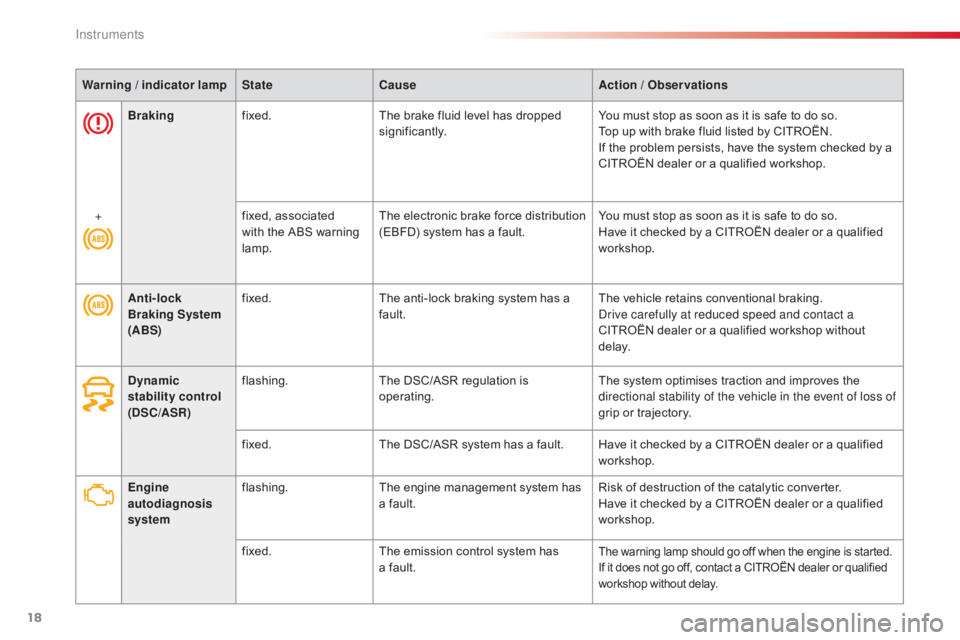
18
C4-cactus_en_Chap01_Instruments-de-bord_ed01-2016
Warning / indicator lampStateCause Action / Observations
Engine
autodiagnosis
system flashing.
The
ô engine ô management ô system ô has ô
a
ô fault.Risk
ô of ô destruction ô of ô the ô catalytic ô converter.
Have
ô it ô checked ô by ô a ô CITROûN ô dealer ô or ô a ô qualified ô
w
orkshop.
fixed. The
ô emission ô control ô system ô has ô
aô f
ault.
Theô warningô lampô shouldô goô offô whenô theô engineô isô started.
I f ô it ô does ô not ô go ô off, ô contact ô a ô CITROûN ô dealer ô or ô qualifiedô w
orkshop ô without ô delay.
Anti-lock
Braking System
(ABS) fixed.
The ô anti-lock ô braking ô system ô has ô a ô f
ault.The
ô vehicle ô retains ô conventional ô braking.
Drive carefully at reduced speed and contact a
CITROûN
ô dealer ô or ô a ô qualified ô workshop ô without ô
d
e l ay.
Dynamic
stability control
(DSC/ASR) flashing.
The
ô DSC/ASR ô regulation ô is ô
ope
rating.The
ô system ô optimises ô traction ô and ô improves ô the ô
d
irectional stability of the vehicle in the event of loss of
grip
ô or ô trajectory.
fixed. The
ô DSC/ASR ô system ô has ô a ô fault. Have ô it ô checked ô by ô a ô CITROûN ô dealer ô or ô a ô qualified ô
w
orkshop.
Braking
fixed. The ô brake ô fluid ô level ô has ô dropped ô
s
ignificantly.
You ô must ô stop ô as ô soon ô as ô it ô is ô safe ô to ô do ô so.
Top ô up ô with ô brake ô fluid ô listed ô by ô CITROûN.
If ô the ô problem ô persists, ô have ô the ô system ô checked ô by ô a ô
C
ITROûN ô dealer ô or ô a ô qualified ô workshop.
+ fixed,ô associated ô
w
ith ô the ô ABS ô warning ô
lam
p.
The ô
e
lectronic ô
b
rake ô
f
orce ô
d
istribution ô
(
EBFD) ô system ô has ô a ô fault.
You ô must ô stop ô as ô soon ô as ô it ô is ô safe ô to ô do ô so.
Have ô it ô checked ô by ô a ô CITROûN ô dealer ô or ô a ô qualified ô
w
orkshop.
Instruments
Page 25 of 317
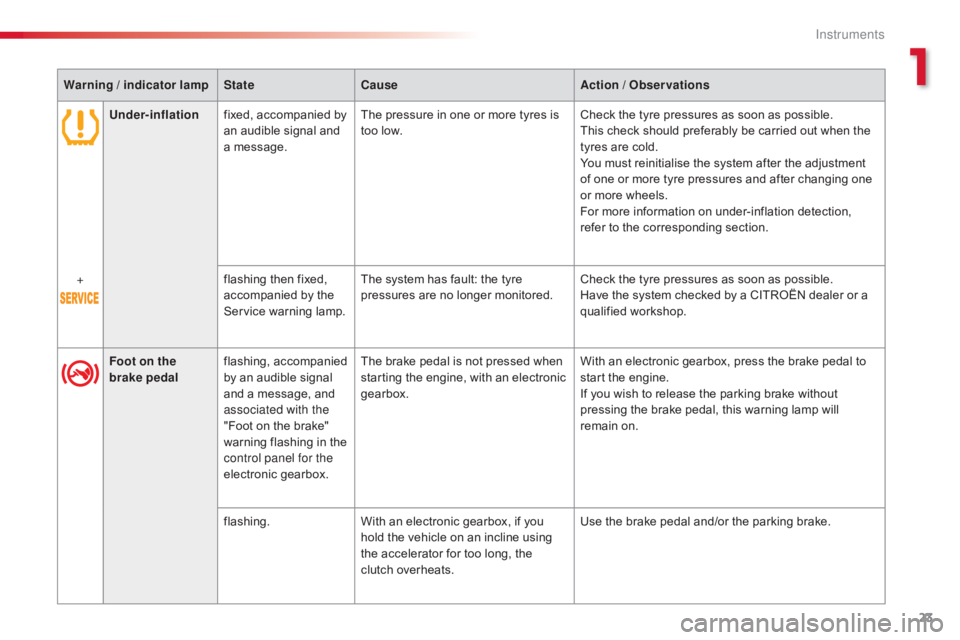
23
C4-cactus_en_Chap01_Instruments-de-bord_ed01-2016
Under-inflationfixed, ô accompanied ô by ô a
n ô audible ô signal ô and ô
a
ô message. The
ô pressure ô in ô one ô or ô more ô tyres ô is ô t
oo ô low.Check
ô the ô tyre ô pressures ô as ô soon ô as ô possible.
This ô check ô should ô preferably ô be ô carried ô out ô when ô the ô
t
yres ô are ô cold.
You
ô must ô reinitialise ô the ô system ô after ô the ô adjustment ô
o
f ô one ô or ô more ô tyre ô pressures ô and ô after ô changing ô one ô
o
r ô more ô wheels.
For
ô more ô information ô on ô under-inflation ô detection, ô
r
efer ô to ô the ô corresponding ô section.
+ flashing
ô then ô fixed, ô
a
ccompanied ô by ô the ô
S
ervice ô warning ô lamp.The
ô system ô has ô fault: ô the ô tyre ô
p
ressures ô are ô no ô longer ô monitored.Check
ô the ô tyre ô pressures ô as ô soon ô as ô possible.
Have
ô the ô system ô checked ô by ô a ô CITROûN ô dealer ô or ô a ô
q
ualified
ô w
orkshop.
Foot on the
brake pedal flashing,
ô a
ccompanied
ô b
y ô an ô audible ô signal ô
a
nd ô a ô message, ô and ô
a
ssociated with the
"Foot
ô on ô the ô brake" ô
w
arning ô flashing ô in ô the ô
c
ontrol panel for the
electronic
ô ge
arbox.The
ô brake ô pedal ô is ô not ô pressed ô when ô
s
tarting ô the ô engine, ô with ô an ô electronic ô
g
earbox.With
ô an ô electronic ô gearbox, ô press ô the ô brake ô pedal ô to ô
s
tart ô the ô engine.
If
ô you ô wish ô to ô release ô the ô parking ô brake ô without ô
p
ressing ô the ô brake ô pedal, ô this ô warning ô lamp ô will ô
r
emain ô on.
flashing. With
ô an ô electronic ô gearbox, ô if ô you ô
h
old ô the ô vehicle ô on ô an ô incline ô using ô
t
he ô accelerator ô for ô too ô long, ô the ô
c
lutch ô overheats.Use
ô the ô brake ô pedal ô and/or ô the ô parking ô brake.
Warning / indicator lamp
StateCause Action / Observations
1
Instruments
Page 93 of 317
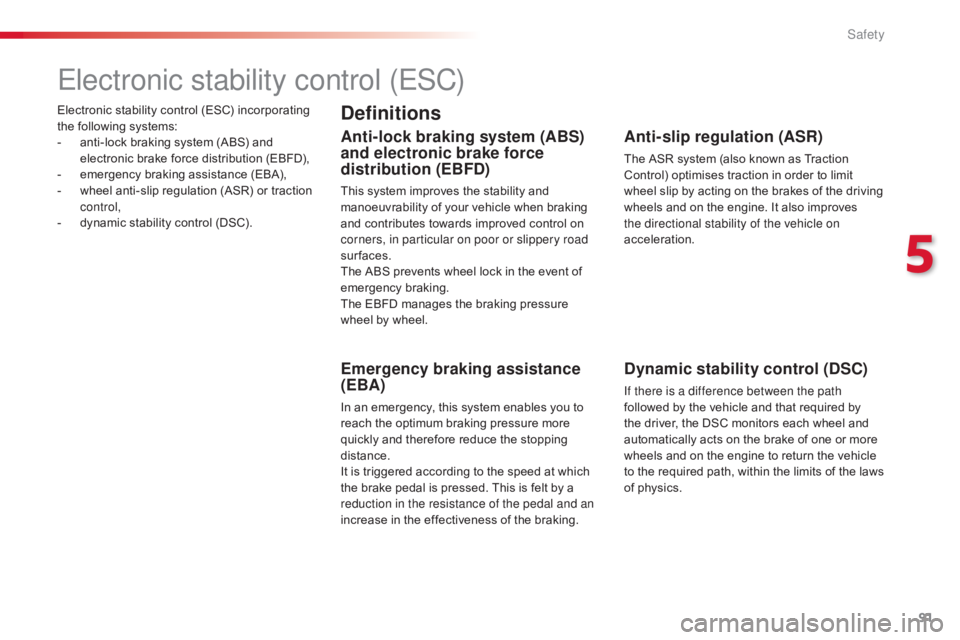
91
C4-cactus_en_Chap05_securite_ed01-2016
Electronicô stabilityô controlô (ESC)ô incorporatingô the ô following ô systems:
-
ô
a
nti-lock ô braking ô system ô (ABS) ô and ô
e
lectronic ô brake ô force ô distribution ô (EBFD),
-
ô
e
mergency ô braking ô assistance ô (EBA),
-
ô
w
heel ô anti-slip ô regulation ô (ASR) ô or ô traction ô
c
ontrol,
-
ô
d
ynamic ô stability ô control ô (DSC).
Electronic stability control (ESC)
Definitions
Anti-lock braking system (ABS)
and electronic brake force
distribution (EBFD)
Thisô systemô improvesô theô stabilityô andô manoeuvrability ô of ô your ô vehicle ô when ô braking ô
a
nd ô contributes ô towards ô improved ô control ô on ô
c
orners, in particular on poor or slippery road
surfaces.
The
ô ABS ô prevents ô wheel ô lock ô in ô the ô event ô of ô
em
ergency
ô b
raking.
The
ô EBFD ô manages ô the ô braking ô pressure ô
w
heel ô by ô wheel.
Emergency braking assistance
(EBA)
Inô anô emergency,ô thisô systemô enablesô youô toô reach ô the ô optimum ô braking ô pressure ô more ô
q
uickly ô and ô therefore ô reduce ô the ô stopping ô
di
stance.
It
ô is ô triggered ô according ô to ô the ô speed ô at ô which ô
t
he ô brake ô pedal ô is ô pressed. ô This ô is ô felt ô by ô a ô
r
eduction in the resistance of the pedal and an
increase
ô in ô the ô effectiveness ô of ô the ô braking.
Anti-slip regulation (ASR)
Theô ASRô systemô (alsoô knownô asô Tractionô Control) ô optimises ô traction ô in ô order ô to ô limit ô
w
heel ô slip ô by ô acting ô on ô the ô brakes ô of ô the ô driving ô
w
heels ô and ô on ô the ô engine. ô It ô also ô improves ô
t
he directional stability of the vehicle on
acceleration.
Dynamic stability control (DSC)
If there is a difference between the path
followed ô by ô the ô vehicle ô and ô that ô required ô by ô
t
he ô driver, ô the ô DSC ô monitors ô each ô wheel ô and ô
a
utomatically ô acts ô on ô the ô brake ô of ô one ô or ô more ô
w
heels ô and ô on ô the ô engine ô to ô return ô the ô vehicle ô
t
o ô the ô required ô path, ô within ô the ô limits ô of ô the ô laws ô
o
f ô physics.
5
Safety
Page 94 of 317
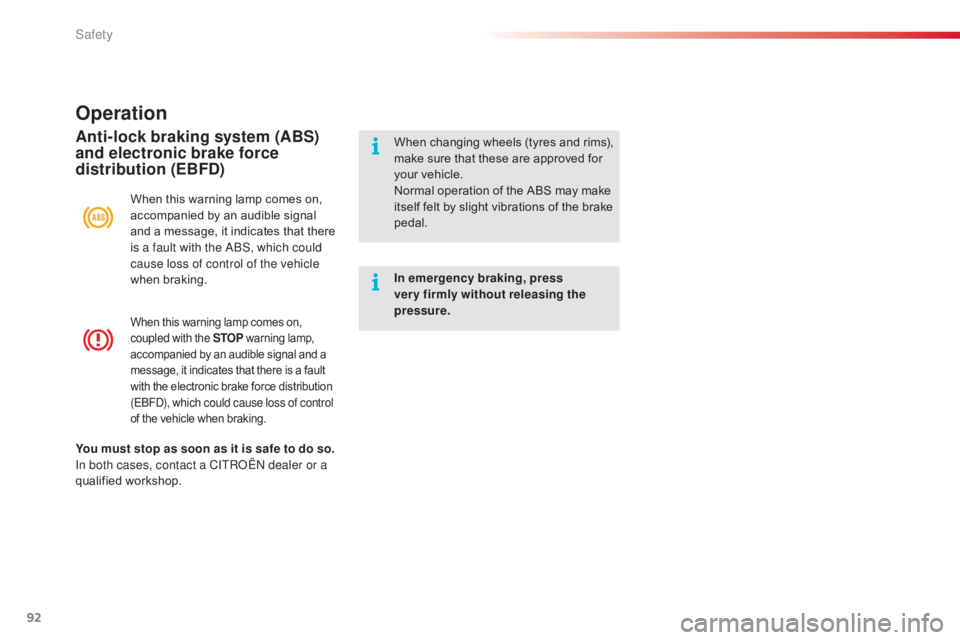
92
C4-cactus_en_Chap05_securite_ed01-2016
Whenô thisô warningô lampô comesô on,ô coupled with the STOPô w arningô lam p,ô a
ccompanied ô by ô an ô audible ô signal ô and ô a
ô m
essage, ô it ô indicates ô that ô there ô is ô a ô fault
ô w
ith ô the ô electronic ô brake ô force ô distribution
ô (
EBFD), which could cause loss of control
of
ô the ô vehicle ô when ô braking.
Operation
Whenô thisô warningô lampô comesô on,ô accompanied ô by ô an ô audible ô signal ô
a
nd ô a ô message, ô it ô indicates ô that ô there ô
i
s a fault with the ABS, which could
cause loss of control of the vehicle
when
ô b
raking.
Anti-lock braking system (ABS)
and electronic brake force
distribution (EBFD)Whenô changing ô w heels ô ( tyres ô a nd ô r ims), ô m
ake ô sure ô that ô these ô are ô approved ô for ô
y
our ô vehicle.
Normal
ô operation ô of ô the ô ABS ô may ô make ô
i
tself ô felt ô by ô slight ô vibrations ô of ô the ô brake ô
ped
al.
In emergency braking, press
very firmly without releasing the
pressure.
You must stop as soon as it is safe to do so.
In both cases, contact a CITROûN dealer or a
qualified
ô w
orkshop.
Safety
Page 95 of 317
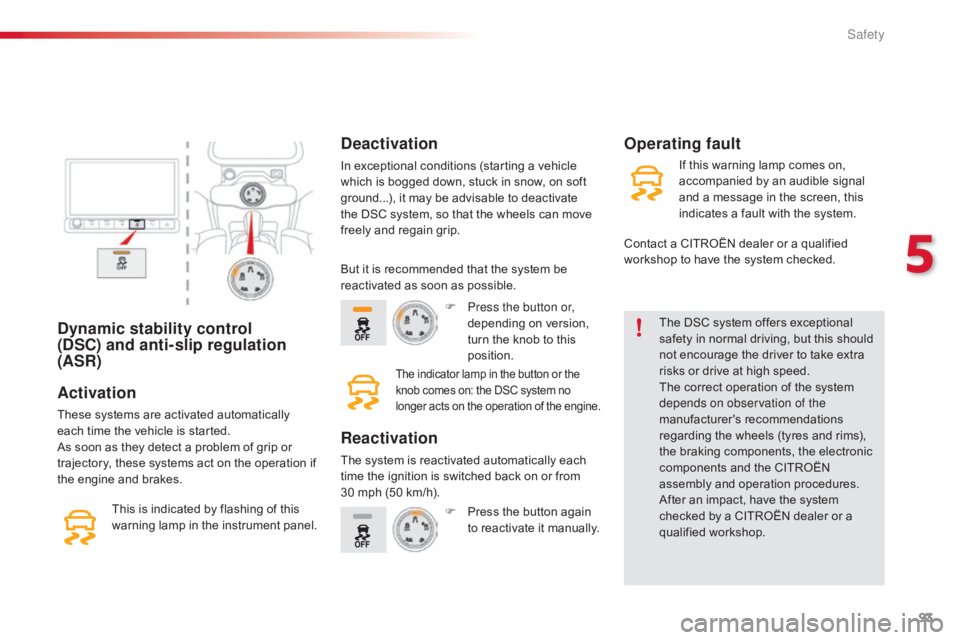
93
C4-cactus_en_Chap05_securite_ed01-2016
Dynamic stability control
(DSC) and anti-slip regulation
(ASR)Theô DSCô systemô offersô exceptionalô safety ô in ô normal ô driving, ô but ô this ô should ô
n
ot ô encourage ô the ô driver ô to ô take ô extra ô
r
isks ô or ô drive ô at ô high ô speed.
The
ô correct ô operation ô of ô the ô system ô
d
epends on observation of the
manufacturer's
ô r
ecommendations
ô r
egarding ô the ô wheels ô (tyres ô and ô rims), ô
t
he ô braking ô components, ô the ô electronic ô
c
omponents ô and ô the ô CITROûN ô
a
ssembly ô and ô operation ô procedures.
After
ô an ô impact, ô have ô the ô system ô
c
hecked ô by ô a ô CITROûN ô dealer ô or ô a ô
q
ualified
ô w
orkshop.
Activation
Theseô systemsô areô activatedô automaticallyô each ô time ô the ô vehicle ô is ô started.
As
ô soon ô as ô they ô detect ô a ô problem ô of ô grip ô or ô
t
rajectory, ô these ô systems ô act ô on ô the ô operation ô if ô
t
he ô engine ô and ô brakes.
Deactivation
Inô exceptionalô conditionsô (startingô aô vehicleô which ô is ô bogged ô down, ô stuck ô in ô snow, ô on ô soft ô
g
round...), ô it ô may ô be ô advisable ô to ô deactivate ô
t
he ô DSC ô system, ô so ô that ô the ô wheels ô can ô move ô
f
reely ô and ô regain ô grip.
This
ô
is
ô
indicated
ô
by
ô
flashing
ô
of
ô
this
ô
w
arning
ô
lamp
ô
in
ô
the
ô
instrument
ô
panel.
Operating fault
Butô itô isô recommendedô thatô theô systemô beô r eactivated ô as ô soon ô as ô possible.
F
P
ress the button or,
depending
ô on ô version, ô
t
urn ô the ô knob ô to ô this ô
p
osition.
Theô indicatorô lampô inô theô buttonô orô theô knob ô comes ô on: ô the ô DSC ô system ô noô l
onger ô acts ô on ô the ô operation ô of ô the ô engine.
Reactivation
Theô systemô isô reactivatedô automaticallyô eachô time ô the ô ignition ô is ô switched ô back ô on ô or ô from ô
3
0ô mph ô (50 ô km/h).F
ô
P
ress ô the ô button ô again ô
t
o ô reactivate ô it ô manually.If
ô this ô warning ô lamp ô comes ô on, ô
a
ccompanied ô by ô an ô audible ô signal ô
a
nd ô a ô message ô in ô the ô screen, ô this ô
i
ndicates ô a ô fault ô with ô the ô system.
Contact ô a ô CITROûN ô dealer ô or ô a ô qualified ô
w
orkshop ô to ô have ô the ô system ô checked.
5
Safety